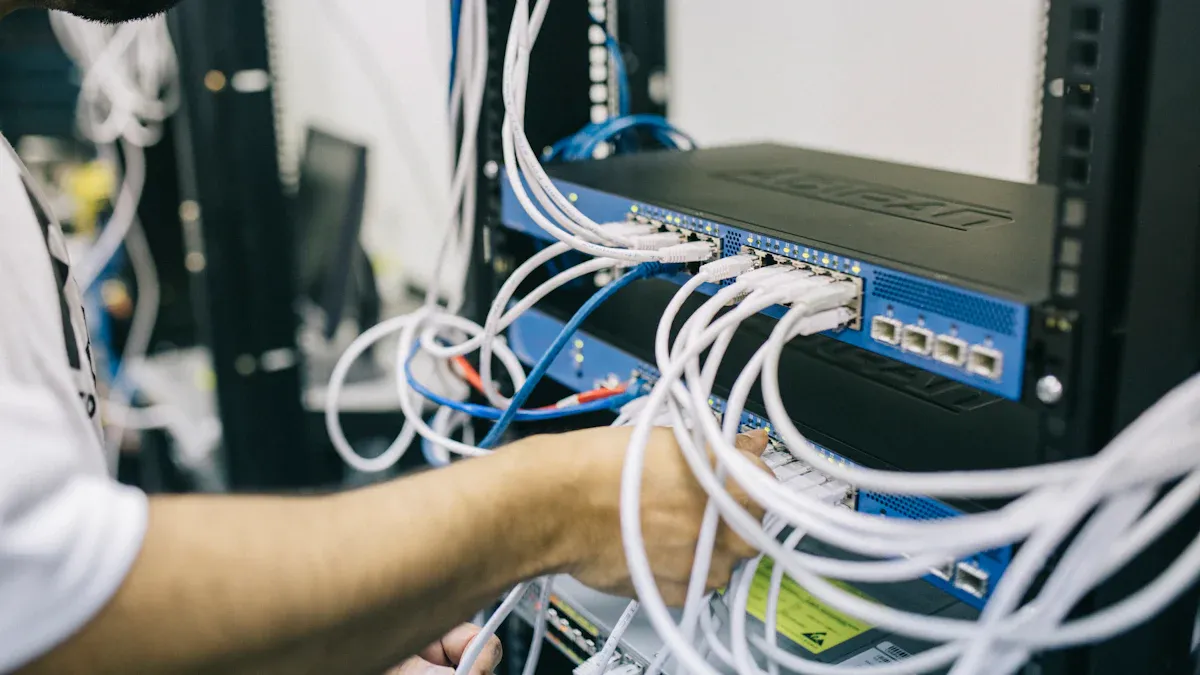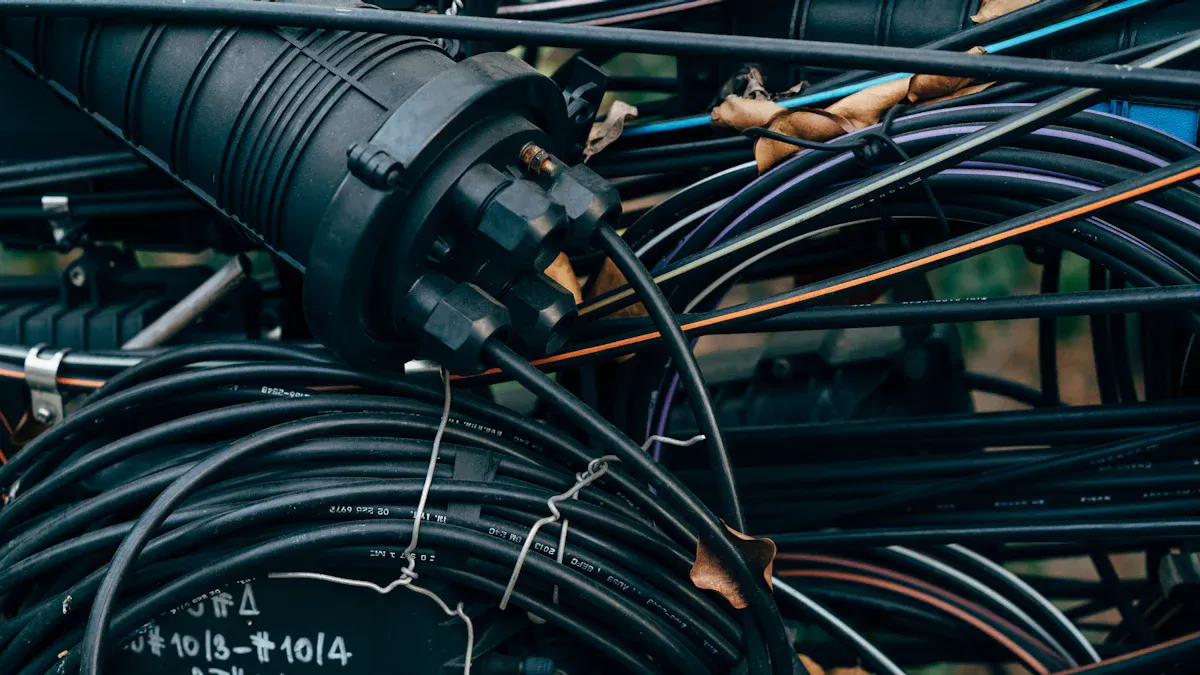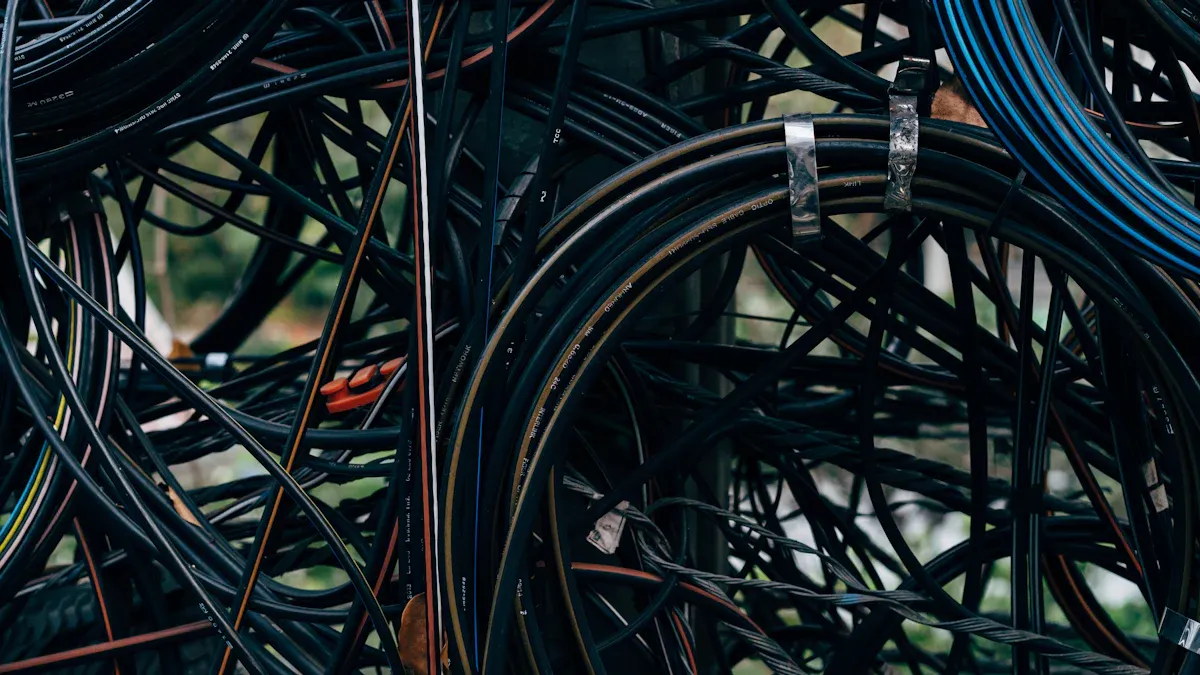
When you begin the installation of indoor multi-core armored cable, you must focus on choosing the correct cable and following all safety rules. If you select the wrong armored fiber optic cable for indoor use or use poor installation practices, you increase the risk of short circuits, fires, and equipment failure. Every year, electrical fires from wiring and connections affect about 1 in 67 homes, with almost half of these losses linked to faulty infrastructure. Always check that your indoor multi-core armored fiber optic cable meets your project’s needs and follows local codes.
Key Takeaways
- Choose the right indoor multi-core armored cable that fits your environment and meets local safety codes.
- Use proper tools and safety gear to protect yourself and ensure a neat, damage-free installation.
- Plan carefully by measuring accurately, routing cables safely, and securing them to avoid damage and future problems.
- Follow correct termination and connection steps, then test and inspect your work to guarantee safety and reliability.
- Perform regular maintenance and inspections to keep your cable system safe and working well over time.
Key Pre-Installation Considerations for Installation of Indoor Multi-Core Armored Cable
Assessing Suitability for Indoor Use
Before you start the installation of indoor multi-core armored cable, you need to check if the cable fits your indoor environment. Look at the building layout and see if there are any sharp corners or tight spaces. Make sure the cable can bend without damage. Some cables work better in dry areas, while others handle moisture. You should also think about the temperature inside the building. If the area gets very hot or cold, pick a cable that can handle those changes.
Tip: Always read the manufacturer’s guide to see if the cable is rated for indoor use.
Understanding Cable Specifications and Ratings
You must understand the cable’s specifications before you begin. Check the voltage rating and the number of cores. Each core carries a signal or power, so count how many you need for your project. Look at the armor type. Some cables have steel tape, while others use aluminum. The armor protects the cable from damage. Also, check the fire rating. Many indoor cables must meet fire safety standards.
Here is a quick checklist:
- Voltage rating
- Number of cores
- Armor material
- Fire safety rating
Compliance with Local Codes and Standards
You need to follow local codes and standards for the installation of indoor multi-core armored cable. These rules keep you safe and help prevent accidents. Local codes may tell you where you can run the cable and how to secure it. Some areas require special permits or inspections. Always check with your local building authority before you start.
Note: Following codes is not just about safety. It also helps you avoid fines and delays.
Essential Tools and Materials for Installation of Indoor Multi-Core Armored Cable

List of Required Tools
You need the right tools to make your installation safe and efficient. Each tool has a specific job. Using the correct tool helps you avoid damage to the cable and keeps your work neat.
- Cable cutters: Cut the armored cable cleanly.
- Wire strippers: Remove insulation from the wires.
- Armored cable stripper: Strip the armor without harming the inner wires.
- Insulated screwdrivers: Tighten or loosen screws safely.
- Pliers: Hold, bend, or twist wires.
- Measuring tape: Measure cable runs accurately.
- Utility knife: Trim sheathing or tape.
- Cable glands and gland spanner: Secure the cable ends.
Tip: Always check your tools before starting. Damaged tools can cause accidents.
Recommended Safety Gear
You must protect yourself during the installation of indoor multi-core armored cable. International standards, such as those from the International Electrotechnical Commission (IEC) and EN 62444:2013, require you to use personal protective equipment (PPE) and insulated tools. These rules help prevent electrical hazards and keep you safe.
- Safety glasses: Shield your eyes from flying debris.
- Insulated gloves: Protect your hands from electric shock.
- Hard hat: Guard your head in case of falling objects.
- Safety shoes: Prevent foot injuries from heavy tools or cable.
- Ear protection: Use if you work in a noisy area.
Following these safety guidelines is not just a suggestion. Regulatory bodies endorse these practices to protect you and ensure reliable electrical systems.
Checklist of Materials
Gather all materials before you begin. This step saves time and helps you avoid mistakes.
| Material | Purpose |
|---|---|
| Multi-core armored cable | Main cable for power or signal transfer |
| Cable glands | Secure and seal cable ends |
| Cable ties | Bundle and organize cables |
| Mounting clips/brackets | Fix cables to walls or ceilings |
| Electrical tape | Insulate and protect connections |
| Junction boxes | House cable connections |
| Labels | Mark cables for easy identification |
Prepare all materials in advance. This makes the installation of indoor multi-core armored cable smoother and more organized.
Step-by-Step Installation of Indoor Multi-Core Armored Cable

Site Preparation and Planning
You need to start with careful site preparation. Begin by reviewing all design drawings for your project. This step helps you understand the cable routes and any special requirements. Walk through the installation area and look for obstacles, such as sharp corners or other building systems. Make sure you have clear access to all cable paths.
Before you bring any materials to the site, inspect them for damage or defects. Only use cables and accessories that meet your project’s standards. Hold a pre-construction meeting with your team. Assign roles and responsibilities so everyone knows what to do. This approach matches best practices seen in large projects like the Nord Plaza cable tray installation, where teams coordinate closely and inspect materials before starting work.
Follow these steps for effective site preparation:
- Study the design drawings and cable layout plans.
- Inspect all materials and tools for quality.
- Hold a team briefing to discuss the installation plan.
- Check the site for hazards or obstacles.
- Coordinate with other trades to avoid conflicts.
- Document your plan and keep records for future reference.
Tip: Ongoing inspections during and after installation help you maintain high quality and safety.
Measuring and Cutting the Cable
Accurate measuring and cutting are essential for a successful installation of indoor multi-core armored cable. Use a measuring tape to determine the exact length needed for each cable run. Always add a little extra length to allow for connections and any unexpected changes in the route.
Mark the cable clearly before cutting. Use a cable cutter designed for armored cables to make a clean, straight cut. This method prevents damage to the inner wires. The IEEE Recommended Practice for Cable Installation highlights the importance of precise measuring and correct cable sizing. These steps help you avoid waste and ensure reliable connections.
Follow this process for measuring and cutting:
- Measure the planned cable route from start to finish.
- Add extra length for terminations and slack.
- Mark the cable at the cutting point.
- Use the correct tool to cut the cable cleanly.
- Inspect the cut end for sharp edges or damage.
Always double-check your measurements before cutting. Mistakes at this stage can lead to costly delays.
Routing and Securing the Cable
Proper routing and securing protect your cable from damage and ensure a neat installation. Plan the route to avoid sharp bends, high-traffic areas, and sources of heat or moisture. Use cable trays, conduits, or mounting clips to support the cable along its path.
Many industry projects, such as those at major airports and industrial plants, show that precise cable routing and secure fixing are critical for safety and performance. These projects use certified cables, follow technical standards, and document every step to meet strict regulations.
Here are some best practices for routing and securing:
- Route the cable along planned paths, avoiding hazards.
- Use cable ties or mounting clips to secure the cable at regular intervals.
- Keep the cable away from sharp edges and moving parts.
- Label each cable for easy identification.
- Protect the cable from mechanical damage during and after installation.
Secure cables properly to prevent sagging or movement, which can cause wear over time. Good cable management also makes future maintenance easier.
Termination and Connection Procedures
You need to handle the termination and connection of indoor multi-core armored cables with care. This step ensures that your electrical or data system works safely and reliably. Start by preparing the cable ends. Use an armored cable stripper to remove the outer sheath and armor. Take care not to nick or damage the inner insulation or conductors.
Follow these steps for proper termination:
- Strip the outer sheath and armor to expose the inner wires.
- Trim the wires to the correct length for your connectors or terminals.
- Strip the insulation from each core, leaving enough exposed wire for a solid connection.
- Attach cable glands to the ends. These glands protect the cable and provide strain relief.
- Insert each core into its terminal or connector. Tighten the screws or clamps securely.
- Double-check that each wire is in the correct position and that there are no loose strands.
Tip: Always use connectors and terminals that match the cable size and type. This prevents overheating and poor connections.
You should also label each terminated cable. Clear labeling helps you identify circuits during future maintenance or troubleshooting. Many professionals use heat-shrink labels or printed tags for this purpose.
A table can help you remember the main points:
| Step | Purpose |
|---|---|
| Strip sheath/armor | Expose inner wires |
| Trim and strip cores | Prepare for connection |
| Attach glands | Provide protection and relief |
| Connect wires | Ensure safe, solid connection |
| Label cables | Easy identification |
Testing and Inspection
After you finish the installation of indoor multi-core armored cable, you must test and inspect your work. Testing helps you find problems before the system goes live. Inspection ensures that your installation meets safety standards and works as planned.
Begin with a visual inspection. Look for signs of damage, loose connections, or exposed wires. Check that all cable glands and connectors are tight. Make sure labels are clear and correct.
Next, use testing tools to check the cable:
- Use a continuity tester to confirm that each core carries current from end to end.
- Use an insulation resistance tester to check for shorts or leaks between cores.
- For data cables, use a network tester to verify signal quality.
Note: Always follow the manufacturer’s instructions for each testing tool. This ensures accurate results.
If you find any issues, fix them before you power up the system. Document your test results and keep them for future reference. Many local codes require you to keep these records as proof of a safe installation.
A simple checklist for testing and inspection:
- [ ] Visual inspection complete
- [ ] All connections tight and secure
- [ ] Continuity test passed
- [ ] Insulation resistance test passed
- [ ] Labels checked and correct
- [ ] Test results documented
You should never skip testing and inspection. These steps protect your equipment and keep people safe.
Safety Precautions and Common Mistakes in Installation of Indoor Multi-Core Armored Cable
Electrical Safety Tips
You must always put safety first when working with electricity. Before you start, turn off the power at the main breaker. Use a voltage tester to make sure the wires are not live. Wear insulated gloves and safety glasses to protect yourself from shocks and sparks. Never touch exposed wires with your bare hands. Keep your work area dry and free from water. If you feel unsure about any step, ask a qualified electrician for help.
Tip: Always double-check that the power is off before you begin the installation of indoor multi-core armored cable.
Avoiding Physical and Mechanical Damage
You need to protect the cable from damage during and after installation. Do not drag the cable across rough surfaces. Use cable trays or conduits to support the cable and keep it off the floor. Avoid bending the cable too sharply. Sharp bends can break the inner wires. Secure the cable with clips or ties, but do not pull them too tight. Tight clips can crush the cable and cause problems later.
A simple table can help you remember how to avoid damage:
| Action | Why It Matters |
|---|---|
| Use cable trays | Prevents crushing and cuts |
| Avoid sharp bends | Protects inner conductors |
| Secure with care | Stops movement and sagging |
Mistakes to Avoid During Installation
You can prevent many problems by avoiding common mistakes. Do not skip reading the manufacturer’s instructions. Each cable may have special requirements. Do not mix up the wires inside the cable. Always label each wire clearly. Do not leave extra cable coiled up in tight spaces. Coils can cause overheating. Never rush the job. Take your time to check each connection and test your work.
Remember: Careful planning and attention to detail help you achieve a safe and reliable installation.
Final Checks and Maintenance for Installation of Indoor Multi-Core Armored Cable
Post-Installation Inspection
You need to perform a careful inspection after you finish the installation of indoor multi-core armored cable. This step helps you catch any problems before you use the system. Start by checking all cable routes. Make sure the cables stay secure and do not sag or touch sharp edges. Look at each connection point. Confirm that all terminals feel tight and that no wires stick out.
Use this checklist to guide your inspection:
- Check that all cable glands are tight and sealed.
- Make sure labels are clear and match your records.
- Inspect for any signs of damage, such as cuts or crushed spots.
- Test each circuit with a continuity tester.
- Review your documentation to confirm you followed the plan.
Tip: Take photos of your finished work. Photos help you with future maintenance and troubleshooting.
Ongoing Maintenance Recommendations
You should keep your installation in good shape with regular maintenance. Set a schedule to inspect the cables every six months. During each check, look for signs of wear, loose fittings, or changes in the environment that could affect the cables.
Here are some simple steps for ongoing maintenance:
- Walk along the cable routes and look for damage.
- Tighten any loose cable glands or mounting clips.
- Replace worn labels to keep identification easy.
- Clean dust and debris from cable trays and junction boxes.
- Record any changes or repairs in your maintenance log.
A table can help you organize your maintenance tasks:
| Task | Frequency | Notes |
|---|---|---|
| Visual inspection | Every 6 months | Look for damage |
| Tighten fittings | Every 6 months | Check all connections |
| Update labels | As needed | Keep labels readable |
| Clean cable areas | Every 6 months | Remove dust and debris |
| Log updates | Every visit | Track all changes |
Regular maintenance keeps your installation of indoor multi-core armored cable safe and reliable for years.
You should always focus on safety and follow local codes during the installation of indoor multi-core armored cable. Use the right tools for each step. Double-check your work to avoid mistakes. Stay updated on the latest rules and best practices. Careful planning helps you finish your project safely and correctly.
Remember: Good preparation leads to a reliable and safe cable system.
FAQ
What is a multi-core armored cable?
A multi-core armored cable has several insulated wires inside a strong metal layer. You use it to protect signals or power from damage. This cable works well in places where you need extra safety and durability.
Can you install indoor armored cable in wet areas?
You can install some indoor armored cables in damp areas if the manufacturer says it is safe. Always check the cable’s rating. Look for water-resistant or moisture-proof labels before you start your project.
How do you know if your cable is installed correctly?
You should check all connections, labels, and cable routes. Use a tester to confirm each wire works. Inspect for damage or loose fittings. Keep a record of your tests and inspections for future reference.
What tools do you need for installation?
You need cable cutters, wire strippers, an armored cable stripper, insulated screwdrivers, and pliers. You also need safety gear like gloves and glasses. A table can help you remember:
| Tool | Use |
|---|---|
| Cable cutters | Cut cable |
| Wire strippers | Remove insulation |
| Insulated screwdrivers | Tighten screws |
Do you need a permit to install indoor armored cable?
You often need a permit for electrical work. Always check with your local building authority before you start. Permits help you follow safety rules and local codes.
By: Consult
Tel: +86 574 27877377
Mb: +86 13857874858
E-mail: henry@cn-ftth.com
Youtube: DOWELL
Pinterest: DOWELL
Facebook: DOWELL
Linkedin: DOWELL
Post time: Jun-26-2025
